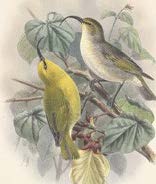Kaua‘i Nuku Pu‘u

Pair of Kauaʻi nukupuʻu. Picture: Rothschild Collection
Names
- ʻŌlelo Hawaiʻi: Kaua‘i nuku pu‘u
- Scientific: Hemignathus lucidus hanapepe
Conservation Status
- Presumed Extinct
- Federally Listed as Endangered
- State Listed as Endangered
- State Recognized as Endemic
- NatureServe Heritage Rank G1T1—Critically Imperiled
- IUCN Red List Ranking—Critically Endangered (Potentially Extinct)
- Revised Recovery Plan for Hawaiian Forest Birds—USFWS 2006
Species Information
The Kaua‘i nuku pu‘u is a large, short-tailed Hawaiian honeycreeper (Family: Fringillidae) with a long, thin decurved bill; the lower mandible is half the length of the upper mandible. Nuku pu‘u also are known from O‘ahu (H. l. lucidus) and Maui (H. l. affinis); the O‘ahu subspecies is certainly extinct. Currently, all nuku pu‘u are considered one species, however, ongoing research suggests that populations occurring on the three islands are distinct species. Adult males are olive green with a yellow head, throat, and breast and have a small black mask; females are grayish green above and whitish below. Little is known about the species’ life history. Often joins mixed species hunting groups, especially those with ‘akikiki (Oreomystis bairdi). Apparently would creep along tree trunks, especially those of ōhi‘a (Metrosideros polymorpha) and koa (Koa acacia) trees, searching the bark and dead wood for arthropod prey; also may have taken nectar. Accounts vary regarding bill use. Either hammered surfaces, similar to its congener the ‘akiapōlā‘au (H. munroi), or used its upper mandible to fish out prey from crevices, catching them with its tongue and lower mandible. No information on the species’ breeding biology, but likely is similar to the ‘akiapōlā‘au.
Distribution
Unknown. Probably extinct. All recent Kaua‘i nuku pu‘u sightings are from a small area of southwestern Kaua‘i between 610 and 1,220 meters (2,000–4,000 feet) elevation. The species’ historic range also appeared very restricted.
Habitat
Mesic and wet montane forests. Habitat conditions of the species’ historic range vary and all presumably support Culex mosquitoes. Areas where Kaua‘i nuku pu‘u were most recently been observed are managed by the State of Hawai‘i.
Threats
Unknown. However, the Kaua‘i nuku pu‘u likely was susceptible to the same factors that threaten other native Hawaiian forest birds including habitat loss and degradation, predation by introduced mammals, and disease. For Kaua‘i nuku pu‘u, the following likely was of particular concern:
- Disease. The precipitous decline of all nuku pu‘u taxa suggests that mosquito-borne diseases played an important role in the species’ demise.
Additional Resources
For more information and references visit the DLNR State Wildlife Action Plan factsheets. DOFAWʻs species pages and State Wildlife Action Plan fact sheets are provided for general information and are not meant to be a citable, original source of data. If you are a student, researcher, or writer looking for a citable source, please explore the references below or find other original data sources, rather than citing these webpages. The references below were provided by the authors of the State Wildlife Action Plan fact sheets at the time of drafting:
- Foster JT, Tweed EJ, Camp RJ, Woodworth BL, Adler CD, Telfer T. 2004. Long-term population changes of native and introduced birds in the Alaka‘i swamp, Kaua‘i. Conservation Biology 18:716-725.
- IUCN Red List of Threatened Species. 2015. Version 2014.3. Available at: www.iucnredlist.org. (Accessed May 2015).
- Pratt TK, Fancy SG, Ralph CJ. 2001 ‘Akiapola‘au (Hemignathus munroi) and nukupu‘u (Hemignathus lucidus). In The Birds of North America, No. 600 (Poole A, Gill F, editors.). Philadelphia, (PA): The Academy of Natural Sciences; and Washington DC: The American Ornithologists’ Union.
- Scott JM, Mountainspring S, Ramsey FL, Kepler CB. 1986. Forest bird communities of the Hawaiian islands: their dynamics, ecology and conservation. Lawrence, (KS): Cooper Ornithological Society.
- U.S. Fish and Wildlife Service. 2006. Revised Recovery plan for Hawaiian forest birds. Portland, (OR): U.S. Fish and Wildlife Service.
